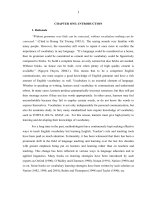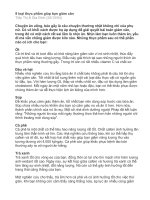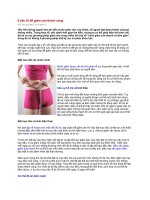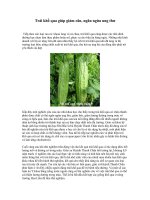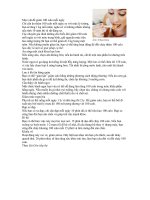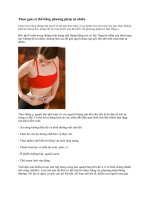Life without bread giảm cân
Bạn đang xem bản rút gọn của tài liệu. Xem và tải ngay bản đầy đủ của tài liệu tại đây (29.39 MB, 260 trang )
\
LIFE,
Without
BREAD
How a
Can Save Your
Diet
•
Discover how
even cure
•
Learn
—
how
Low-Carbohydrate
a
Life
low-carbohydrate/high-protein diet can prevent
— and
heart disease, diabetes, and gastrointestinal disorders
to feel better
and
live
longer by changing the way you eat
Develop strategies to transition from high-
to low-carbohydrate nutrition
Christian B. Allan, Ph.D.
& Wolfgang
Lutz,
M.D.
/
{
..
v
LTL
^
BJ-CODRtY-ppBLIC
II
LIBT
ARY
w
3'18B 3'(ttttt*ft3» '
LIFE
WITHOUT BREAD
Life
J||||LL
Without
Bread
How a
Low-Carbohydrate Diet
Can Save Your Life
Christian B. Allan, Ph.D.
and
Wolfgang
Q
KEATS PUBLISHING
LOS ANGELE
NTQContemporary
S
Publishing Group
Lutz,
M.D.
The purpose
of this book
is
to educate. It
is
sold with the understanding that the
publisher and author shall have neither liability nor responsibility for any injury
caused or alleged to be caused by the information contained in this book. While
every effort has been
made
to ensure
its
accuracy, the book's contents should not be
construed as medical advice. Each person's health needs are unique.
ommendations appropriate
to
your particular
To
obtain rec-
situation, please consult a qualified
health care provider.
Library of Congress Cataloging-in-Publication Data
Allan, Christian B.
Life without bread
:
how a
low-carbohydrate diet can save your
life /
Christian B. Allan, and Wolfgang Lutz.
cm.
p.
Includes bibliographical information and index.
ISBN
1.
0-658-00170-1 (paper)
Low-carbohydrate
diet.
I.
Lutz, Wolfgang, 1913-11. Title.
RM237.73 .A455 2000
613.2'83— dc21
00-030507
Published by Keats Publishing,
A division of NTC/Contemporary Publishing Group,
4255 West Touhy Avenue, Lincolnwood (Chicago),
Copyright
© 2000 by
All rights reserved.
a retrieval system,
Inc.
Illinois
60646-1975 U.S.A.
Christian B. Allan and Wolfgang Lultz
No part of this book may be reproduced,
stored in
or transmitted in any form or by any means, electronic,
mechanical, photocopying, recording, or otherwise, without the prior
permission of NTC/Contemporary Publishing Group, Inc.
Design by Robert
S.
Tinnon Design
Printed in the United States of America
International Standard
00 01 02 03 04 05
Book Number: 0-658-00170-1
DHD
18 17 16 15 14 13 12 11 10 9 8 7 6 5 4
3 2 1
HP
Contents
Foreword by Kilmer
S.
Acknowledgments
Introduction
McCully, M.D.
vii
xi
xiii
CHAPTER ONE
What
Is
Low-Carbohydrate Nutrition!
1
CHAPTER TWO
An
Old Idea: The History of
Low- Carbohydrate Nutrition
9
CHAPTER THREE
Carbohydrates and Hormones:
Balance Your
Way to
Optimal Health
21
CHAPTER FOUR
Diabetes and Insulin Resistance
33
CHAPTER FrVE
Energy: Less
CHAPTER
Is
More
55
SIX
Heart Disease: From Fat
to Fiction
73
CONTENTS
CHAPTER SEVEN
Qastrointestinal Disorders:
Reduction, Relief, and Restoration
111
CHAPTER EIGHT
Weight Control
131
CHAPTER NINE
Vitamins, Minerals, and
Cofactors:
The Myths Revealed
147
CHAPTER TEN
Cancer: Another Disease of Sugar Metabolism?
163
CHAPTER ELEVEN
Evidence from Evolution: The True Fad Diet
CHAPTER TWELVE
The Low- Carbohydrate Program in
Practice: What You Need to Know
Appendix: Carbohydrate Table
References
Index
233
225
195
219
179
—
¥
Foreword
The principal nutritional advice of
Bread
Life Without
are correspondingly increased to achieve a balance of calories
fresh,
whole foods. This sensible and reasonable advice
made during
the observations that Dr. Lutz
sands of patients with
many
his
different diseases
career as an internist in Austria. It
is
also based
is
and
limit dietary carbohydrates. In this approach, dietary proteins
to
fats
from
based on
is
treatment of thou-
throughout
on
a large
his
long
amount of
current scientific and medical data published throughout the world.
Observations of the benefit of low-carbohydrate nutrition are explored beginning with Herodotus in the
fifth
century B.C., continuing
with Savarin and Banting in the nineteenthth century, and culminating with Steffanson and Price in the twentieth century. Moreover, the
approach in
Life
Without Bread
is
thoroughly compatible with cur-
rent knowledge of nutrition in the Paleolithic era of human evolution.
The
so-called "diseases of
Western
civilization"
—heart
obesity, hypertension, diabetes, cancer, dental caries,
became pervasive
in
human
disease,
and others
populations of developed nations dur-
ing the twentieth century primarily because of the consumption of
a diet
sugar.
rosis
containing refined carbohydrates, especially white flour and
The development
of the homocysteine theory of arterioscle-
during the past three decades explains the origin of arte-
riosclerosis
vitamin
B6
,
and heart disease
folic acid,
as a deficiency
of three
B
vitamins:
and vitamin B 12 Epidemiological and
.
clinical
Framingham Heart Study, the Nurses' Health
Canada Study, the Physicians' Health Study,
and many more, have proven that deficiencies of these B vitamins
studies,
such
as the
Study, the Nutrition
FOREWORD
Vlll
lead to elevation of blood homocysteine levels and increased
tality
from coronary heart
that animal fat
is
disease.
not detrimental to
dietary deficiencies of these
tive vitamins
These same
human
B vitamins
is
health.
The
reason for
destruction of these sensi-
during milling of grains into white
flour, extraction
sugar from plants, and other types of harsh food processing.
fact that
vitamin
B 12
is
of
The
only obtained from animal foods suggests
that the recent decrease in animal food
by high-carbohydrate
mor-
studies also indicate
diets
may be
consumption accompanied
responsible for
B 12
deficiencies.
Consumption of refined carbohydrates and other processed foods
B vitamins and micronutrients in developed countries, contributing in a major way to "diseases of Westleads to deficiencies of other
ern civilization."
Beginning with observations of elevated cholesterol and
els
lipid lev-
of victims of vascular disease and the production of fibrolipid
plaques in the arteries of animals fed cholesterol, the cholesterol
hypothesis was developed in the early twentieth century to explain
the origin of vascular disease. As pointed out in Life Without Bread,
the hypothesis that dietary cholesterol
is
responsible for elevation of
blood cholesterol has never been proven.
An
unfortunate conse-
quence of the unproven and outmoded cholesterol hypothesis has
been the misguided dietary advice given to the public by various
governmental agencies and professional societies to consume a lowfat
low-cholesterol diet.
By restricting
dietary
fats,
meats, and dairy
consuming carbohydrates, as advised
by the Food Pyramid promulgated by the U. S. Department of
Agriculture. The current epidemic of obesity, diabetes and hyperfoods, the public has turned to
tension
among
adults
and children in the United States
is
a conse-
quence of overconsumption of carbohydrates, especially refined
grain foods. According to the nutritional advice of Life Without
Bread, restriction of dietary carbohydrates will counteract the in-
creased susceptibility to these "diseases of Western civilization."
Decreased dietary carbohydrates
cretion and
min B 6
,
insulin resistance
folic acid,
will decrease excessive insulin se-
and
amount of vitafrom fresh, whole foods,
will increase the
and vitamin B 12
Foreword
preventing numerous problems including elevation of blood
homo-
cysteine levels and vascular disease susceptibility.
Improvement
in dietary quality, as
recommended
Bread, offers the best chance to reduce
problems associated with Western
many
in Life Without
of the current health
civilization.
Kilmer
S.
McCully, M.D.
Providence,
Rhode
Island
February 2000
J||Dk
HIP
Acknowledgments
I
owe a great debt to Wolfgang Lutz for providing some of
on low-carbohydrate nutrition ever accumulated by one individual. It is his evidence from
more than forty years of clinical practice that makes Life Without
the most comprehensive long-term data
Bread so powerful and
I
would
also like to
sights into nutrition
difficult to ignore.
thank
and
Thomas Nufert
disease. It
was
for his invaluable in-
at his insistence that I
began
exploring the medical and biochemical relevance of low-carbohydrate
nutrition.
A special
thank-you goes to
my wife, Jenny,
for her help in edit-
ing the manuscript and her constant support. She,
one, has
I
I
made
this
wish to thank
book
more than any-
possible.
many of the
teachers, professors,
and researchers
have been associated with over the years. Although some did not
agree with the premise of Life Without Bread, they compelled
me
to
fully evaluate the alternatives.
I
extend
my
sincerest thank-you to Peter
Hoffman, Senior Edi-
tor of Keats Publishing. Peter has been a valuable guide in writing
this
book and
a
very patient editor. His experience and suggestions
have contributed significantly to
his friendship
is
my ability to
finish this
book, and
appreciated.
Christian
B.
Allan, Ph.D.
ACKNOWLEDGMENTS
Xll
My first book was written and published in Germany in
title,
Leben Ohne Brot, translates into the
out Bread. I wish to
early interest in
my
title
acknowledge Dr. E.
1967. Its
of this book: Life With-
Idris
and Verlag for their
nutritional findings and research, and for the
publication of Leben Ohne Brot.
I
me
am
extremely grateful to Chris Allan for his
and for keeping the pledge he made to
would write an English language
and hard work are the reason
I
wish to thank the people
in
my
contact with
in Austria, that
he
book came
to be.
Keats Publishing who have been as-
sociated with this project and the
worked with
initial
Life Without Bread. His dedication
this
at
me
many
associates that
I
have
long career. Their research and belief in low-
carbohydrate nutrition has
made
a
tremendous impact on
my life.
Wolfgang Lutz, M.D.
•Jim
Introduction
CJver THE LAST few years,
est in
there has been a resurgence of inter-
low-carbohydrate nutrition as the best way to lose weight and
maintain health. As with most ideas that contradict conventional
mainstream theories, low-carbohydrate nutrition generates considerable controversy. Unfortunately for
trition
is
all
of us, the truth about nu-
not always dominated by what
is
actually healthful, but
often by special interests, ego, and a lack of proper education needed
to evaluate the available information. Equally important,
ple
who
most peo-
are proponents of a "pet" theory have not taken the time to
They
may be
evaluate contradictory information in an unbiased fashion.
often refuse to consider the alternatives, even though there
good evidence
for these different ideas.
The low-fat theory of nutrition is
troduction, even though
erative disease
The
it
at center stage as I write this in-
has not stopped the incidence of degen-
from skyrocketing over the
last thirty
or
more
years.
information presented in this book will clearly show that the
low-fat theory of health and disease
Life Without
wrong.
Bread convincingly outlines the unmistakable benefits
of low-carbohydrate nutrition.
ical files
is
It
of Dr. Wolfgang Lutz,
presents actual data from the
who
med-
has used low-carbohydrate nu-
on many thousands of patients in Austria and Germany for
more than forty years. He has put together powerful evidence that
trition
proper
tein,
here
human
nutrition should emphasize high animal fat and pro-
not high carbohydrates.
—
far
A mountain of information is presented
beyond anything ever before published
in the
United States
INTRODUCTION
on
This book shows
this topic.
actually reverse
—and
in
However, Dr. Lutz
In
diet.
fact,
we had
But
diet.
how
as
at
our
low-carbohydrate nutrition can
cases cure
didn't always
both of us were,
of the low-fat
lives,
some
some
own
—many
different diseases.
champion
low-carbohydrate
a
stage of our careers, proponents
health began to fade early in our
to explore other nutritional alternatives.
The
results
of
our journey to vibrant health follow in the pages of this book.
We have written Life
mal
health. It
is
Without Bread to help people achieve opti-
our hope that even those
who
are adamantly against
this book beAmerican readers.
low-carbohydrate nutrition will take the time to read
cause
Our
for
much
of the information will be
intention
all
of us to
authors
who
is
new
to
to dig deeply into the lifestyle changes necessary
live
happy, healthy
lives.
We also hope that the many
publish books on this subject will use our information
to help support the
wisdom of low-carbohydrate
nutrition.
So sit back, grab a handful of beef jerky and a glass of whole milk,
and enjoy. We believe this journey will be one of the most important
ones of your life, as it has been for us, our relatives and friends, and
the thousands of people
who have
already benefited from the power
of low-carbohydrate nutrition.
Christian
B.
Allan, Ph.D.
Brookville,
Maryland
January 2000
Ml
CHAPTER ONE
What
Is
Low- Carbohydrate
Nutrition?
CONTRARY TO CURRENT POPULAR WISDOM,
not
fat,
that contribute to
many dietary related
it is
carbohydrates,
diseases.
You may be wondering what carbohydrates are, how many carhow one can realistically
bohydrates are in different foods, and
maintain low-carbohydrate nutrition for the rest of one's
life? Let's
components of foods. There are
three types of macronutrients that constitute most of what we con-
begin with a closer look
sume: proteins,
fats,
at the
and carbohydrates.
PROTEINS
Proteins are the most abundant
component of our
cells
and
tissue.
The name protein comes from the Greek word proteios, meaning "of
first importance." They perform an amazing array of functions
throughout our body. They include enzymes, antibodies, hormones,
and transport molecules, and are even components of the skeleton.
There
teins,
are twenty
common amino acids that constitute most promany less common amino acids that are also
but there are
important.
However, there are eight amino acids that are essential. Essential
means that they must be obtained in the diet because the body cannot make them from other nutrients and raw materials supplied in
the diet. In many instances, nutrients can be made from simple
LIFE
WITHOUT BREAf)
building blocks directly within our
cannot be made in
The
essential
this way.
amino
cells,
acids
must be consumed
only foods that supply
obtained in the
diet.
acids are valine, lysine, threonine, leucine,
isoleucine, tryptophan, phenylalanine,
amino
but the essential nutrients
They must be
all
and methionine. These eight
in the diet,
and animal foods are the
eight in one single source. People
who do
not eat animal foods run the risk of deficiencies in the essential
amino
acids. All
of them can be obtained from nonanimal foods,
but no single plant food contains
the
body needs
order to
all
make important
acids are supplied, the
become
all
eight. Studies
have shown that
of the essential amino acids in the same meal in
amino
of them
proteins. If only a few essential
body does not
amino
store
available; instead, the
them
acids are
until
all
broken down and
one of many reasons that animal foods are very
eliminated. This
is
important in the
human
diet.
FATS
Fats (sometimes called fatty acids or
diverse functions in the body.
lipids)
They are
have
many important and
the primary storage form of
energy in the body and supply the most energy to our
heart, for example, uses primarily fat for
its
The
cells.
energy. Fats are the
major constituents of cell membranes. Cell membrane integrity and
permeability to various biomolecules
functions. Finally,
members of
is critical
a select class
for proper metabolic
of lipids function as
hormones.
There
are
two known
linolenic acid.
These
essential fatty acids: linoleic acid
trary to popular wisdom, saturated fat
will explore this in detail
said
about
The
it
and alpha-
fatty acids are classified as unsaturated.
is
Con-
actually very healthy.
throughout the book, but
a little
We
should be
here.
terms saturated and unsaturated are used to denote the
amount of hydrogen atoms that are contained on each carbon atom
in the fat molecule. The more unsaturated the fat, the fewer hydro-
What Is Low-Carbohydrate
gen atoms there
unsaturated
are.
fats are
are chemically
more
Nutrition'.
A consequence of fewer hydrogen atoms is that
more
chemically
stable.
reactive, while saturated fats
Why does
this
matter? Saturated fatty
more resistant to oxidation, which means membranes that
contain more saturated fat are less susceptible to oxidation. Many
studies have shown that the types of fat associated with membranes
acids are
are related to the types of fat
consumed.
Research has repeatedly emphasized the value of antioxidants, yet
seems to have overlooked the
fact that, unlike unsaturated fat, satu-
rated fat alone can resist oxidation. Saturated fat does not require a
secondary molecule, such as an antioxidant, to eliminate the negative effect
of oxidation.
The two
all
essential fatty acids
can be found in varying degrees in
animal foods, as well as in nuts and vegetable
oils.
Animal foods
tend to supply equal amounts of the two essential fatty acids,
whereas vegetable
oils typically
contain predominantly one or the
other of the essential fatty acids.
CARBOHYDRATES
Carbohydrates are primarily used
as
an energy source.
They are
also
often attached to proteins to enhance the recognition and specific
transport properties of proteins.
Some forms of carbohydrates are
known carbohydrates that help
part of cartilage, and there are a few
eliminate toxins from the body.
To our knowledge,
there has never been an essential carbohy-
drate discovered. Every carbohydrate your
from either protein or
there
is
fat.
This
is
not
a
ample evidence to support the
nutrition
is
very healthy and
is
body needs can be made
we dwell on because
point
fact that
low-carbohydrate
the proper nutrition for humans, re-
gardless of whether carbohydrates are essential or not.
esting, however, that
even in nature there
dietary necessity placed
on carbohydrates
for
is
not
It is inter-
much
humans.
specific
LIFE
Carbohydrates are
WITHOUT BREAL?
classified as either
ples of simple carbohydrates are sugar
hydrates are found in
cereals.
many
Exam-
simple or complex.
and honey. Complex carbo-
foods, including potatoes, bread, and
You probably have heard the term "starch" associated with
is just another way of saying that potatoes contain
potatoes. This
carbohydrates.
As
far as
food
is
concerned, carbohydrates are simply different
forms of sugar. Simple carbohydrates contain one sugar molecule,
or two sugar molecules linked together.
contain
many
rides. All
Complex carbohydrates
sugar molecules linked together, called polysaccha-
of these act like sugar in our bodies.
testinal juices
Our stomach and
in-
can break apart the complex carbohydrates, and our
bodies see them as a simple sugar.
Complex carbohydrates may be
absorbed into our bloodstream more slowly than simple carbohydrates, but they
lative effect
still
break
down
into simple sugars. It
is
cumu-
the
of eating large amounts of carbohydrates that can lead
to a host of health problems.
To
when you eat any carbohydrate
The implications of this will be disbut for now don't be fooled by those who say that some
repeat this important point,
you are
cussed
essentially eating sugar.
later,
carbohydrates are healthy because they are complex carbohydrates.
A Utilizable Carbohydrate
By "utilizable," we mean the amount of carbohydrate that actually gets
into the bloodstream when we eat certain foods. Let's look at a few examples. A medium apple that weighs approximately 100 grams contains
about 12 grams of utilizable carbohydrate; in other words,
percent utilizable carbohydrate. That means that
when you
it is
12
eat this
apple, you actually eat about 12 grams of carbohydrate. However, if
you eat 100 grams of white bread (four or five slices), you actually consume about 50 grams of carbohydrates because white bread has more
than 50 percent utilizable carbohydrate. Light beer, on the other hand,
contains around 5 percent utilizable carbohydrate (in addition to alco-
What Is Low-Carbohydrate
you drink 250 grams of beer (about half of
hoi), so if
you would be getting about
8 ounces),
The take-home message
is
Nutrition'.
12
for healthful
a glass,
or
grams of carbohydrate.
low-carbohydrate eating
the following:
Restrict all carbohydrates to
12 utilizable grams per day.
Eat as much of any other foods as you
That's
all
there
cated formulas.
nutritional
is
The
program
to
it.
There
is
no need
to
wish.
memorize compli-
following pages describe our low-carbohydrate
in
more
detail.
THE BASICS
Permitted Foods
•
Fish
•
Any type
of animal meat (beef, pork, chicken, lamb), sausage,
cold cuts
•
Eggs
•
Cheese, sour cream, cream cheese, plain yogurt (without
•
All kinds of animal fats
sugar), cream, milk (in
•
Salads, leaves
moderate amounts)
and stems of vegetables (asparagus, brussels
sprouts, cauliflower, lettuce, cabbage, broccoli), cucumbers,
avocados, tomatoes (in moderate amounts)
•
Alcoholic beverages (only unsweetened, and in sensible
•
Nuts
amounts)
(in
moderate amounts)
These foods can be prepared any way you
roasted, broiled, barbecued, or steamed. Small
like: fried,
baked,
amounts of breading
LIFE
WITHOUT BREAD
and sauces don't count toward the 72 grams of carbohydrate per
day. Larger amounts will have to be counted, particularly if the
mostly sugar-based (beware of typical barbecue sauces and
sweet-and-sour sauces).
sauce
is
Restricted Foods
•
All carbohydrate-containing foods (breads, pastas, cereals,
grains, potatoes, pastries, bagels)
•
Sweet
•
Sweetened foods of all kinds (yogurt, drinks,
Dried fruits
•
Now,
fruits
this
sounds
you want,
tein as
or less per day.
of fat
easy, doesn't it?
long
when you reduce
I
eat as
much fat and pro-
you keep the carbohydrates to 72 grams
And don't skimp on fat. It is important to eat plenty
as
as
carbohydrates; don't rely on protein only.
You're probably thinking: "If
per day, and
You can
desserts, candy)
eat unlimited
reduce carbohydrate to 72 grams
I
amounts of fat and protein, won't
I
gain
weight?" Perhaps. However, one of the wonderful consequences of
reducing your carbohydrate consumption to a very low amount is that
you won't have the
get
full
appetite to eat too
much
fat
and protein. You
very quickly and will be able to naturally stop eating.
completely opposite
fect
is
"I'll
just
have one more potato chip, pretzel, or piece of candy"; "Just
whole bag so they won't go
I'll
stop"; or "I
stale!"
might
Most people
as well finish the
are actually addicted
one must eat plenty of
to carbohydrates; to
overcome
fatty foods to kill the
urge for more and more carbohydrates.
freely:
ef-
when it comes to sugar and carbohydrates:
one more of those cookies and
Any
will
The
this addiction
foods that contain virtually no carbohydrate can be eaten
fish, eggs, and butter. Foods such as these conno carbohydrate, so they won't count toward your 72
meats, cheese,
tain almost
grams per
day.
What Is Low-Carbohydrate
To make
this
program easy
Nutrition!
to follow,
we have chosen
a special
term to describe the amount of utilizable carbohydrate in any given
weight of food. That term
was introduced
for diabetics.
in
Vienna
At that time,
is
bread unit (or BU).
in the
it
The term bread unit
beginning of the nineteenth century
was already known that diabetics needed
to restrict their intake of carbohydrates.
A half of a roll that weighed
20 grams contained 12 grams of utilizable carbohydrate, and
considered
this
BUs
1
book, hence the
present in a
Exhibit
1.1
title,
Life Without Bread. Exhibit
number of common
was
1
.
1
lists
the
foods.
Bread Units (BUs) and Their Equivalents
Bread Units (BUs)
1
this
We have adopted this terminology in
bread unit (BU).
bread unit
Selected
1
Food
tablespoon sugar, honey, or flour
4 teaspoons dry white or brown
% cup dry pasta
1
slice
(all
rice
kinds)
of bread (wheat, rye, or white)
% of a bagel
Vi
of a
2
tablespoons dried beans
tortilla
2
A cup peas
Vi
of a
A of a
l
1
medium potato
medium yam
cup broccoli
Vi
grapefruit
1
medium
apple
handful of grapes
% cup strawberries
1 ounce dried fruits (2 tablespoons)
1 cup whole or low-fat milk
Vi
cup
V:
cup soda (4 ounces)
1
cup beer
fruit juices (4
(8
ounces)
ounces)
LIFE
WITHOUT BREAI}
Each bread unit is 12 grams of utilizable carbohydrate. Under
program, you are allowed 6 BUs per day:
this
12 grams x 6
You can
BUs =
eat these
milk, candy, or pasta,
less)
12
total grams
any way you
you
can.
of utilizable carbohydrate
like. If
you want
to have pastry,
BUs total (or
we have made a table that
in many common foods. The
But you can only eat 6
per day. In the back of the book
shows the amount of BUs contained
numbers were calculated from the total carbohydrate content of the
foods and then adjusted for utilizable carbohydrate. Remember,
foods that have little or no carbohydrate are not included in the
table because these can be eaten in
drate table
shown
any amounts.
If there are foods
you can use any published carbohyand simply remember that 12 grams of utilizable carbo-
that are not
hydrate equals
1
in the table,
BU.
In the beginning you will have to consult the table often to see
how many BUs you
know from
are eating, but after a while
experience.
you
will
simply
CHAPTER TWO
An Old
The History of
Idea:
Low- Carbohydrate Nutrition
If you ask ten
people how nutrition contributes
to disease
and
We
can
poor health, you would probably get ten different answers.
hardly blame anyone for being confused. There are so
approaches to nutrition that
becomes
it
many different
difficult to trust
any of them.
For instance, vegetarians believe that only food of plant origin
healthy and object to
ians eat only fruit
products, even
and
rice.
that only
all
plant-derived food
contain lots of starch, such as bread, potatoes,
who
fat are
detrimental to their health. There also
only eat raw vegetables because they believe
uncooked plants
are
wholesome. The
list
goes on.
Other people believe that the increasing use of artificial
pesticides,
modern
is it
This
an opinion?
is
a reasonable idea,
Some people
same people eating
cific
by
a lot
it
and hormones
to guarantee the continued health of
So many people base
but has
been proven or
think that food from animals
raised without the use of antibiotics
see these
fertilizer,
and insecticides has led to the increase of many of today's
diseases.
just
is
Some vegetar-
consider milk and milk products harmless but be-
meat and
are vegetarians
foods derived from animals.
and vegetables; others eat
if they
Some
lieve that
all
mankind.
is
the only
way
we
often
on
a spe-
Ironically,
of sweets.
their nutritional ideas
on
hearsay,
study covered by the popular media, or on what they are told
their physician. Here's a typical scenario:
story or magazine article that says fat
formation to some friends, and they
is
tell
You read a newspaper
You relate this in-
unhealthy.
others. Pretty
soon
it is
"the

